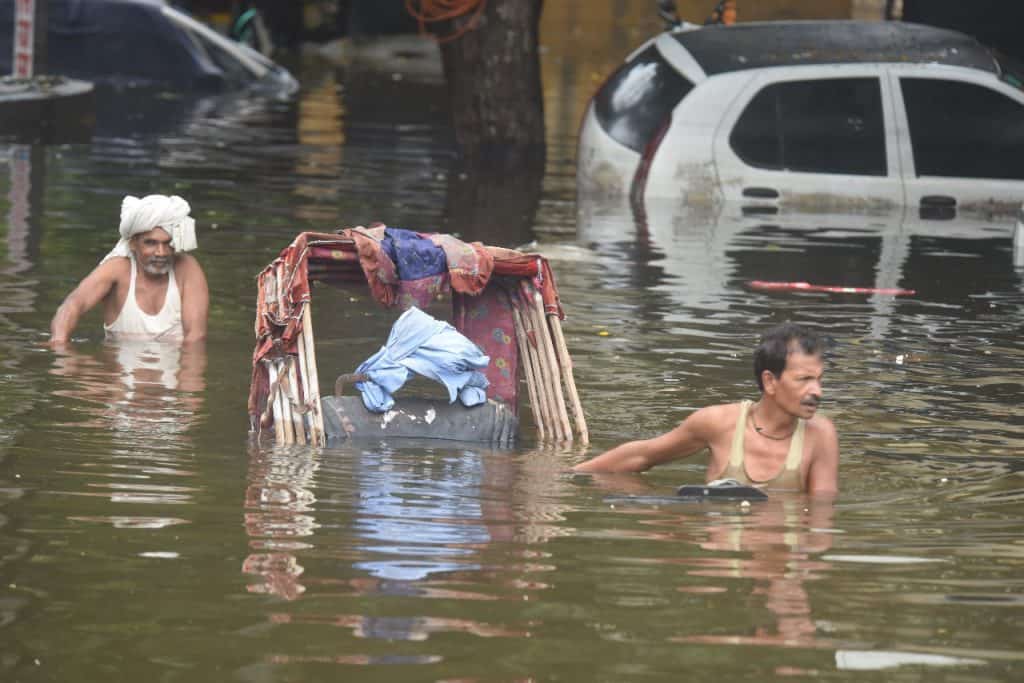Residents of Patna still get goosebumps remembering last year’s ordeal by flood. “There was no drinking water, no food at home, we had to spend the entire night on the roof top,” recalls Mithlesh Kumar a resident of Rajendra Nagar. “The next morning, jawans of the National Disaster Response Force (NDRF) reached our house and evacuated us by boat.”
Much of the city had remained flooded for three weeks last year. The situation was worst in Kankarbagh area when water from the gutter entered homes causing a major health scare. “Human waste was floating in our house,” said Amitesh Sharma, a resident of Kankarbagh locality. “That scenario still haunts us and I pray it will not be repeated this year”.
It won’t, assure officials of the Patna Municipal Corporation (PMC), who have been assigned the task of clearing the drains to prevent flooding. Work on this has begun, but the COVID lockdown presented a convenient excuse to miss the original deadline of May 2nd. Thereafter, a new deadline of May 31st was set, which is about two weeks before monsoon hits Patna, but that too was missed. The deadline has now been revised to June 15th.
Patna Municipal Commissioner Himanshu Sharma said that all nine major drains and four underground drains have been cleaned despite the long lockdown. He also claimed that sufficient precautionary measures were taken during the cleaning of drains to curb the spread of Covid-19. “We had given masks, gloves and soap so that workers could wash their hand on regular intervals.,” said Sharma. “Even social distancing norms were properly followed”.
Getting work done during COVID lockdown
The PMC also took the help of the United National Populations Fund (UNFPA) and launched an initiative named WeCare under which six vehicles were hired and the PMC asked UNFPA to provide counsellors and community mobilisers.
“These vehicles used to visit all the six anchals (circles) in Patna, where this work was going on. These counsellors and community mobilisers used to brief workers on how to keep themselves clean, how to take a bath after going home, how to wear a mask and methods of mask disposal at home. It motivated the workers and gave them confidence,” added Sharma.
Densely populated areas like Bakarganj and the bypass road need particular attention. Patna has 535 drains including 9 big, 14 medium and 172 small ones connected to 39 sump house, which discharge water into adjacent rivers and water bodies. Waste dumped in these drains are the primary cause of water logging, and also makes cleaning them a long and arduous process.
During the lockdown period, PMC used super suction machines to clean the drains. Now that labour is back on the job, Sharma is confident that last year’s flood scenario will not be repeated in 2020. “This time our preparation is of the highest order. Last year there were issues like lack of coordination on the ground, dysfunctional sump houses etc, but not this year,” he said.
Experts say Patna’s saucer shaped topography is another major reason for water logging. To add to that, no new major drainage system has been built since 1968 except in a few select colonies. According to the Master Plan of the Urban Development and Housing Department (UDHD), Patna’s population density is 1100 per square kilometer, with a total population of 20 lakh.
Paper plans
Patna divisional commissioner Sanjay Kumar Agarwal has asked the district magistrate Kumar Ravi to form a team to check if the drainage system has indeed been properly cleaned. “At present I cannot share the detail of the verification of the drainage system as inspection is still being carried out,” said Kumar Ravi. “I have also asked the engineers of the water resources department to ensure that all embankments are safe and the SOP for disaster management must be followed while doing the work related to water logging and floods”.
Besides PMC, the Bihar Urban Infrastructure Development Corporation Limited (BUIDCO) has been tasked with completing the repair work of 39 old sump houses by June 15. No one wants to witness again the sight of the state’s deputy CM Sushil Kumar Modi having to be evacuated by boat when his house got flooded.

After last year’s floods, a high level committee was formed which ordered construction of 17 new sump houses, but this has remained on paper. Apart from this, 27 temporary sump houses are supposed to be made functional before the monsoon. But nothing has been done on this either so far.
A few days back, CM Nitish Kumar and deputy chief minister Sushil Kumar Modi chaired a meeting to take stock of the preparations being made to tackle the city’s water logging problem. Modi said Rs 10 crore had been allotted to make ready 27 temporary sump houses by June 15th. He also said 265 pumping machines of different categories would be procured now that the lockdown is being relaxed. These include vertical, submersible, trolley mounted pumps and diesel generator sets among others. A total of Rs 167 crore has been allotted for machinery and strengthening of embankments.
But engineers at the UDHD say that delay in procurement of machines will delay the completion of the proposed sump houses. “If the machines do not reach Patna on time, a bigger problem will arise,” said one engineer on condition of anonymity. “Even if the drains are cleaned on time, if the sump houses are not functional we will not be able to drain out the water.” Of which there could be plenty, as the meteorology department has predicted a timely monsoon, and a good one at that.